可数名词单数变复数_把单数句变成复数句
- 格式:doc
- 大小:135.54 KB
- 文档页数:4
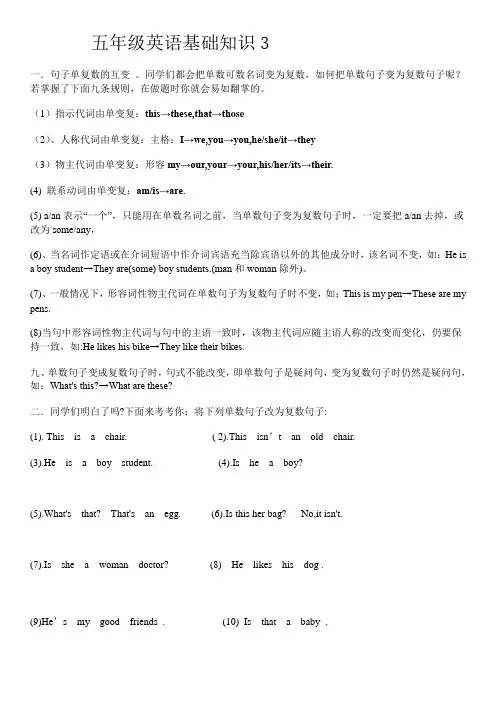
五年级英语基础知识3一.句子单复数的互变。
同学们都会把单数可数名词变为复数,如何把单数句子变为复数句子呢?若掌握了下面九条规则,在做题时你就会易如翻掌的。
(1)指示代词由单变复:this→these,that→th ose(2)、人称代词由单变复:主格:I→we,you→you,he/she/it→they(3)物主代词由单变复:形容my→our,your→your,his/her/its→their.(4) 联系动词由单变复:am/is→are.(5) a/an表示“一个”,只能用在单数名词之前,当单数句子变为复数句子时,一定要把a/an去掉,或改为some/any,(6)、当名词作定语或在介词短语中作介词宾语充当除宾语以外的其他成分时,该名词不变,如:He isa boy student→They are(some) boy students.(man和woman除外)。
(7)、一般情况下,形容词性物主代词在单数句子为复数句子时不变,如:This is my pen→These are my pens.(8)当句中形容词性物主代词与句中的主语一致时,该物主代词应随主语人称的改变而变化,仍要保持一致,如:He likes his bike→They like their bikes.九、单数句子变成复数句子时,句式不能改变,即单数句子是疑问句,变为复数句子时仍然是疑问句,如:What's this?→What are these?二.同学们明白了吗?下面来考考你:将下列单数句子改为复数句子:(1). This is a chair. ( 2).This isn’t an old chair.(3).He is a boy student. (4).Is he a boy?(5).What's that? That's an egg. (6).Is this her bag? No,it isn't.(7).Is she a woman doctor? (8) He likes his dog .(9)He’s my good friends . (10) Is that a baby .。
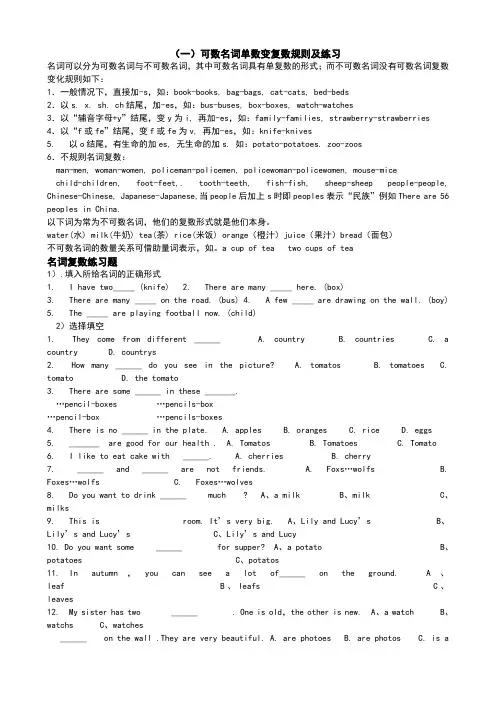
(一)可数名词单数变复数规则及练习名词可以分为可数名词与不可数名词,其中可数名词具有单复数的形式;而不可数名词没有可数名词复数变化规则如下:1.一般情况下,直接加-s,如:book-books, bag-bags, cat-cats, bed-beds2.以s. x. sh. ch结尾,加-es,如:bus-buses, box-boxes, watch-watches3.以“辅音字母+y”结尾,变y为i, 再加-es,如:family-families, strawberry-strawberries 4.以“f或fe”结尾,变f或fe为v, 再加-es,如:knife-knives5. 以o结尾,有生命的加es, 无生命的加s. 如:potato-potatoes. zoo-zoos6.不规则名词复数:man-men, woman-women, policeman-policemen, policewoman-policewomen, mouse-micechild-children, foot-feet,. tooth-teeth, fish-fish, sheep-sheep people-people, Chinese-Chinese, Japanese-Japanese,当people后加上s时即peoples表示“民族”例如There are 56 peoples in China.以下词为常为不可数名词,他们的复数形式就是他们本身。
water(水) milk(牛奶) tea(茶) rice(米饭) orange(橙汁)juice(果汁)bread(面包)不可数名词的数量关系可借助量词表示,如。
a cup of tea two cups of tea名词复数练习题1).填入所给名词的正确形式1. I have two_____ (knife)2. There are many _____ here. (box)3. There are many _____ on the road. (bus)4. A few _____ are drawing on the wall. (boy)5. The _____ are playing football now. (child)2)选择填空1. They come from different ______ A. country B. countries C. a country D. countrys2. How many ______ do you see in the picture? A. tomatos B. tomatoes C. tomato D. the tomato3. There are some ______ in these _______.…pencil-boxes …pencils-box…p encil-box …pencils-boxes4. There is no ______ in the plate. A. apples B. oranges C. rice D. eggs5. _______ are good for our health . A. Tomatos B. Tomatoes C. Tomato6. I like to eat cake with ______. A. cherries B. cherry7. ______ and ______ are not friends. A. Foxs…wolfs B. Foxes…wolfs C. Foxes…wolves8. Do you want to drink ______ much ? A、a milk B、milk C、milks9. This is room. It’s very big. A、Lily and Lucy’s B、Lily’s and Lucy’s C、Lily’s and Lucy10. Do you want some ______ for supper? A、a potato B、potatoes C、potatos11. In autumn,you can see a lot of______ on the ground. A、leaf B、leafs C、leaves12. My sister has two ______ . One is old,the other is new. A、a watch B、watchs C、watches______ on the wall .They are very beautiful. A. are photoes B. are photos C. is aphoto D. is photos14. That’a_____ art book. A. an B. a C. the D are15. There ______ two______ in the box. A. is watch B. are watches C. are watch D. is watches3)请用括号中名词的复数形式填空1. Look at those _______. (child)2. I can see a __________ standing near the door. (policeman) 3. Do you want some ________ for dinner? (potato) 4 In autumn, you can see a lot of _______ on the ground.(leaf) 5. He has two is blue , the other is yellow.( box)6. Two ________ live in this building .( family )4)选择正确的词形1. How many (radioes, radios) can you see?2. There are 36 (boys, boies) in my class.3. Look at those (sheeps, sheep).4.I don’t want (a, an) old cup.5. Give me that (box, boxes), please.6)写出下列单词的复数1. I _________ _________ ___________ ______ _______ _______ ______ . dress ______ _____ ______ 29. puppy_______30. box_______31. knife_______32. fly______ 34. bus______35. bench_____ 36. brush________ . glass_____ . roof_______ . knife______ . people ______ _______ _______ ________73. horse ______74. dog ______用所给的单词的复数的正确形式填空:1 >There are so many________(wolf)in the forest. 2>There are three ______(chair) in the classroom.3>These _______(tomato) are red. 4>______(hero) are great.5>My brother looks after two ______(baby) 6>There are some ______(deer) eating the grass.7>My father likes to eat _______(potato). 8>Chinese ______(people)like to eat noodles.9>I have a lot of ______(toy) in my bedroom. 10>I help my mother wash ______(dish) in the kitchen.11>I have two ______(pencil-box). 12>There are some ______(bus)in the street.13>Peter has eight _____(foot). 14>Linda has three _______(tooth).15>There are some ______(child) in the garden. 16>Michael likes the ______(mouse).17>There are some ______(goose)in the river. 18>My uncle and father are _____(man).19>Tom and King are _____(boy). 20>Linda has three ______(tooth).(二)单数句变复数句的方法及规则1.人称代词单数变成相应的人称代词复数,即a主格:I→we;you→you;she/he/it→they。
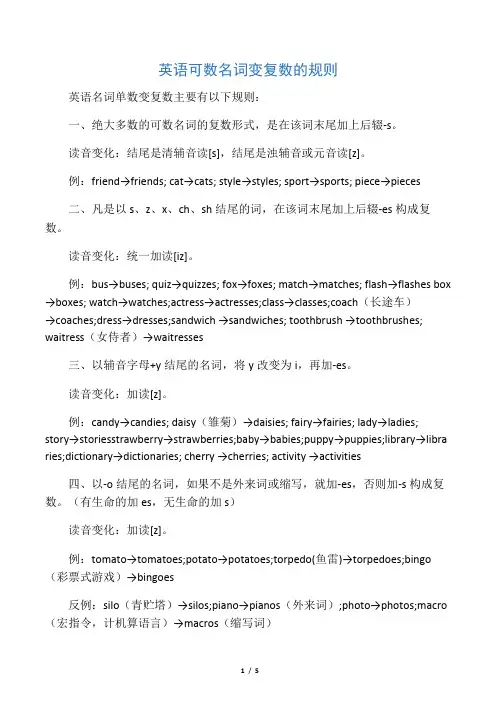
英语可数名词变复数的规则英语名词单数变复数主要有以下规则:一、绝大多数的可数名词的复数形式,是在该词末尾加上后辍-s。
读音变化:结尾是清辅音读[s],结尾是浊辅音或元音读[z]。
例:friend→friends; cat→cats; style→styles; sport→sports; piece→pieces二、凡是以s、z、x、ch、sh结尾的词,在该词末尾加上后辍-es构成复数。
读音变化:统一加读[iz]。
例:bus→buses; quiz→quizzes; fox→foxes; match→matches; flash→flashes box →boxes; watch→watches;actress→actresses;class→classes;coach(长途车)→coaches;dress→dresses;sandwich →sandwiches; toothbrush →toothbrush es; waitress(女侍者)→waitresses三、以辅音字母+y结尾的名词,将y改变为i,再加-es。
读音变化:加读[z]。
例:candy→candies; daisy(雏菊)→daisies; fairy→fairies; lady→ladies;story→storiesstrawberry→strawberries;baby→babies;puppy→puppies;library→libra ries;dictionary→dictionaries; cherry →cherries; activity →activities四、以-o结尾的名词,如果不是外来词或缩写,就加-es,否则加-s构成复数。
(有生命的加es,无生命的加s)读音变化:加读[z]。
例:tomato→tomatoes;potato→potatoes;torpedo(鱼雷)→torpedoes;bingo (彩票式游戏)→bingoes反例:silo(青贮塔)→silos;piano→pianos(外来词);photo→photos;macro (宏指令,计机算语言)→macros(缩写词)五、以-f或-fe结尾的名词,多为将-f或-fe改变为-ves,但有例外。
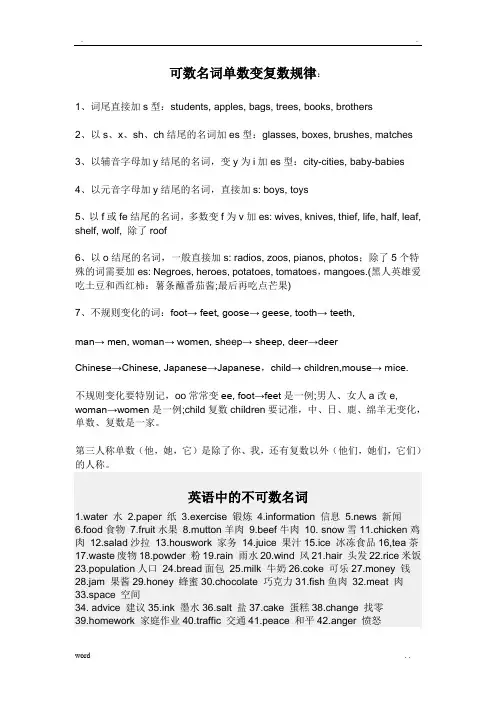
可数名词单数变复数规律:1、词尾直接加s型:students, apples, bags, trees, books, brothers2、以s、x、sh、ch结尾的名词加es型:glasses, boxes, brushes, matches3、以辅音字母加y结尾的名词,变y为i加es型:city-cities, baby-babies4、以元音字母加y结尾的名词,直接加s: boys, toys5、以f或fe结尾的名词,多数变f为v加es: wives, knives, thief, life, half, leaf, shelf, wolf, 除了roof6、以o结尾的名词,一般直接加s: radios, zoos, pianos, photos;除了5个特殊的词需要加es: Negroes, heroes, potatoes, tomatoes,mangoes.(黑人英雄爱吃土豆和西红柿:薯条蘸番茄酱;最后再吃点芒果)7、不规则变化的词:foot→ feet, goose→ geese, tooth→ teeth,man→ men, woman→ women, sh ee p→ sheep, deer→deerChinese→Chinese, Japanese→Japanese,child→ children,mouse→ mice.不规则变化要特别记,oo常常变ee, foot→feet是一例;男人、女人a改e, woman→women是一例;child复数children要记准,中、日、鹿、绵羊无变化,单数、复数是一家。
第三人称单数(他,她,它)是除了你、我,还有复数以外(他们,她们,它们)的人称。
英语中的不可数名词1.water 水2.paper 纸3.exercise 锻炼rmation 信息5.news 新闻6.food食物7.fruit水果8.mutton羊肉9.beef牛肉10. snow雪11.chicken鸡肉12.salad沙拉13.houswork 家务14.juice 果汁15.ice 冰冻食品16,tea茶17.waste废物18.powder 粉19.rain 雨水20.wind 风21.hair 头发22.rice米饭23.population人口24.bread面包k 牛奶26.coke 可乐27.money 钱28.jam 果酱29.honey 蜂蜜30.chocolate 巧克力31.fish鱼肉32.meat 肉33.space 空间34. advice 建议35.ink 墨水36.salt 盐37.cake 蛋糕38.change 找零39.homework 家庭作业40.traffic 交通41.peace 和平42.anger 愤怒43.courage 勇气44.energy 能量45.fear 恐怖46.fun 有趣乐趣47.health 健康48.time 时间49.sand 沙子50.weather天气建议你在学习过程中不断积累。
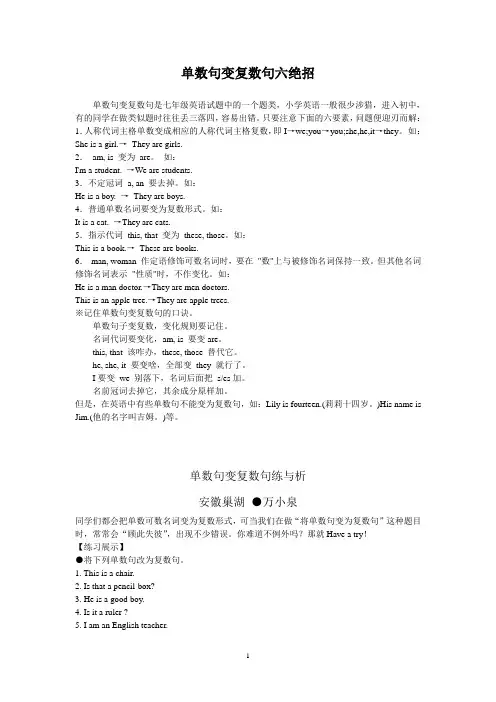
单数句变复数句六绝招单数句变复数句是七年级英语试题中的一个题类,小学英语一般很少涉猎,进入初中,有的同学在做类似题时往往丢三落四,容易出错。
只要注意下面的六要素,问题便迎刃而解:1.人称代词主格单数变成相应的人称代词主格复数,即I→we;you→you;she,he,it→they。
如:She is a girl.→They are girls.2.am, is 变为are。
如:I'm a student. →We are students.3.不定冠词a, an 要去掉。
如:He is a boy. →They are boys.4.普通单数名词要变为复数形式。
如:It is a cat. →They are cats.5.指示代词this, that 变为these, those。
如:This is a book.→These are books.6.man, woman 作定语修饰可数名词时,要在"数"上与被修饰名词保持一致。
但其他名词修饰名词表示"性质"时,不作变化。
如:He is a man doctor.→They are men doctors.This is an apple tree.→They are apple trees.※记住单数句变复数句的口诀。
单数句子变复数,变化规则要记住。
名词代词要变化,am, is 要变are。
this, that 该咋办,these, those 替代它。
he, she, it 要变啥,全部变they 就行了。
I要变we 别落下,名词后面把s/es加。
名前冠词去掉它,其余成分原样加。
但是,在英语中有些单数句不能变为复数句,如:Lily is fourteen.(莉莉十四岁。
)His name is Jim.(他的名字叫吉姆。
)等。
单数句变复数句练与析安徽巢湖●万小泉同学们都会把单数可数名词变为复数形式,可当我们在做“将单数句变为复数句”这种题目时,常常会“顾此失彼”,出现不少错误。
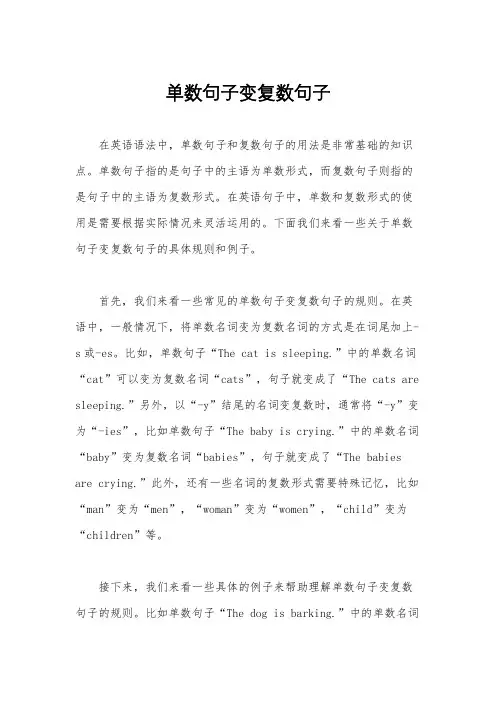
单数句子变复数句子在英语语法中,单数句子和复数句子的用法是非常基础的知识点。
单数句子指的是句子中的主语为单数形式,而复数句子则指的是句子中的主语为复数形式。
在英语句子中,单数和复数形式的使用是需要根据实际情况来灵活运用的。
下面我们来看一些关于单数句子变复数句子的具体规则和例子。
首先,我们来看一些常见的单数句子变复数句子的规则。
在英语中,一般情况下,将单数名词变为复数名词的方式是在词尾加上-s或-es。
比如,单数句子“The cat is sleeping.”中的单数名词“cat”可以变为复数名词“cats”,句子就变成了“The cats are sleeping.”另外,以“-y”结尾的名词变复数时,通常将“-y”变为“-ies”,比如单数句子“The baby is crying.”中的单数名词“baby”变为复数名词“babies”,句子就变成了“The babie s are crying.”此外,还有一些名词的复数形式需要特殊记忆,比如“man”变为“men”,“woman”变为“women”,“child”变为“children”等。
接下来,我们来看一些具体的例子来帮助理解单数句子变复数句子的规则。
比如单数句子“The dog is barking.”中的单数名词“dog”变为复数名词“dogs”,句子就变成了“The dogs are barking.”又比如单数句子“The book is on the table.”中的单数名词“book”变为复数名词“books”,句子就变成了“Thebooks are on the table.”通过这些例子,我们可以更加清晰地理解单数句子变复数句子的规则和用法。
总的来说,单数句子变复数句子是英语语法中的基础知识点,需要我们在日常学习和实践中多加注意和积累。
通过不断地练习和运用,我们可以更加熟练地掌握单数句子变复数句子的规则和用法,从而提高我们的英语表达能力。
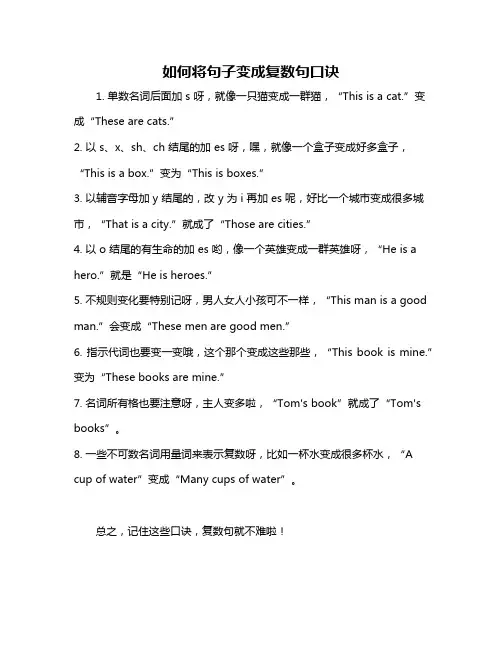
如何将句子变成复数句口诀
1. 单数名词后面加 s 呀,就像一只猫变成一群猫,“This is a cat.”变成“These are cats.”
2. 以 s、x、sh、ch 结尾的加 es 呀,嘿,就像一个盒子变成好多盒子,“This is a box.”变为“This is boxes.”
3. 以辅音字母加 y 结尾的,改 y 为 i 再加 es 呢,好比一个城市变成很多城市,“That is a city.”就成了“Those are cities.”
4. 以 o 结尾的有生命的加 es 哟,像一个英雄变成一群英雄呀,“He is a hero.”就是“He is heroes.”
5. 不规则变化要特别记呀,男人女人小孩可不一样,“This man is a good man.”会变成“These men are good men.”
6. 指示代词也要变一变哦,这个那个变成这些那些,“This book is mine.”变为“These books are mine.”
7. 名词所有格也要注意呀,主人变多啦,“Tom's book”就成了“Tom's book s”。
8. 一些不可数名词用量词来表示复数呀,比如一杯水变成很多杯水,“A cup of water”变成“Many cups of water”。
总之,记住这些口诀,复数句就不难啦!。
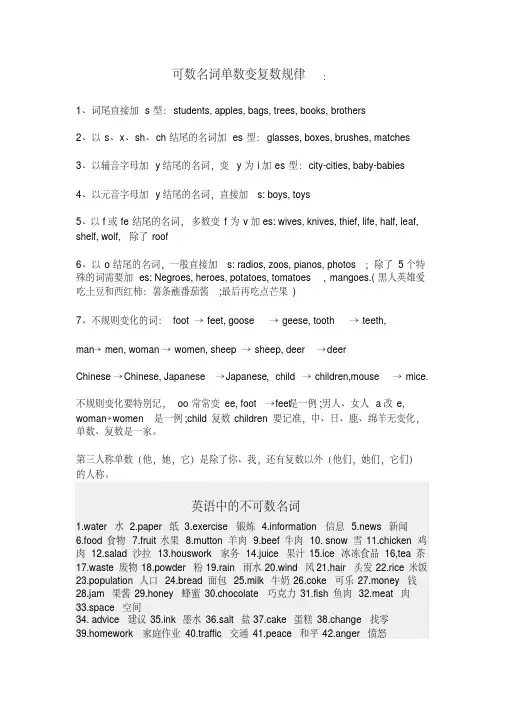
可数名词单数变复数规律:1、词尾直接加s型:students, apples, bags, trees, books, brothers2、以s、x、sh、ch结尾的名词加es型:glasses, boxes, brushes, matches3、以辅音字母加y结尾的名词,变y为i加es型:city-cities, baby-babies4、以元音字母加y结尾的名词,直接加s: boys, toys5、以f或fe结尾的名词,多数变f为v加es: wives, knives, thief, life, half, leaf, shelf, wolf, 除了roof6、以o结尾的名词,一般直接加s: radios, zoos, pianos, photos;除了5个特殊的词需要加es: Negroes, heroes, potatoes, tomatoes,mangoes.(黑人英雄爱吃土豆和西红柿:薯条蘸番茄酱;最后再吃点芒果)7、不规则变化的词:foot→ feet, goose→ geese, tooth→ teeth,man→ men, woman→ women, sheep→ sheep, deer→deerChinese→Chinese, Japanese→Japanese,child→ children,mouse→ mice.不规则变化要特别记,oo常常变ee, foot→feet是一例;男人、女人a改e, woman→women是一例;child复数children要记准,中、日、鹿、绵羊无变化,单数、复数是一家。
第三人称单数(他,她,它)是除了你、我,还有复数以外(他们,她们,它们)的人称。
英语中的不可数名词1.water 水2.paper 纸3.exercise 锻炼rmation 信息5.news 新闻6.food食物7.fruit水果8.mutton羊肉9.beef牛肉10. snow雪11.chicken鸡肉12.salad沙拉13.houswork 家务14.juice 果汁15.ice 冰冻食品16,tea茶17.waste废物18.powder 粉19.rain 雨水20.wind 风21.hair 头发22.rice米饭23.population人口24.bread面包k 牛奶26.coke 可乐27.money 钱28.jam 果酱29.honey 蜂蜜30.chocolate 巧克力31.fish鱼肉32.meat 肉33.space 空间34. advice 建议35.ink 墨水36.salt 盐37.cake 蛋糕38.change 找零39.homework 家庭作业40.traffic 交通41.peace 和平42.anger 愤怒43.courage 勇气44.energy 能量45.fear 恐怖46.fun 有趣乐趣47.health 健康48.time 时间49.sand 沙子50.weather天气建议你在学习过程中不断积累。
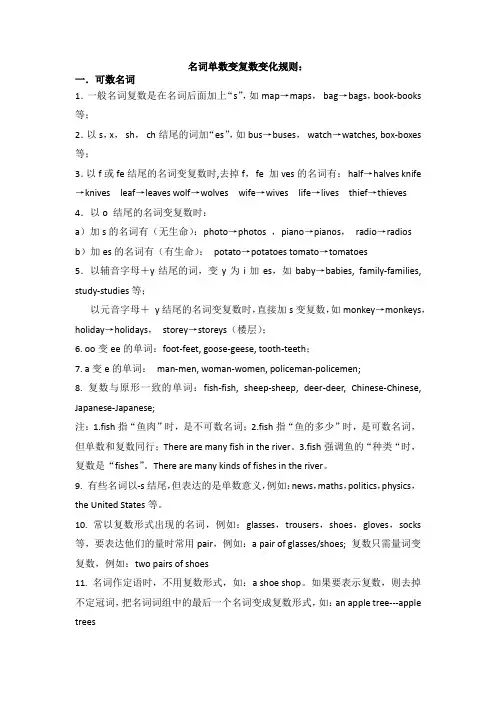
名词单数变复数变化规则:一.可数名词1.一般名词复数是在名词后面加上“s”,如map→maps,bag→bags,book-books 等;2.以s,x,sh,ch结尾的词加“es”,如bus→buses,watch→watches, box-boxes 等;3.以f或fe结尾的名词变复数时,去掉f,fe 加ves的名词有:half→halves knife →knives leaf→leaves wolf→wolves wife→wives life→lives thief→thieves 4.以o 结尾的名词变复数时:a)加s的名词有(无生命):photo→photos ,piano→pianos,radio→radios b)加es的名词有(有生命):potato→potatoes tomato→tomatoes5.以辅音字母+y结尾的词,变y为i加es,如baby→babies, family-families, study-studies等;以元音字母+y结尾的名词变复数时,直接加s变复数,如monkey→monkeys,holiday→holidays,storey→storeys(楼层);6. oo变ee的单词:foot-feet, goose-geese, tooth-teeth;7. a变e的单词:man-men, woman-women, policeman-policemen;8. 复数与原形一致的单词:fish-fish, sheep-sheep, deer-deer, Chinese-Chinese, Japanese-Japanese;注:1.fish指“鱼肉”时,是不可数名词;2.fish指“鱼的多少”时,是可数名词,但单数和复数同行;There are many fish in the river。
3.fish强调鱼的“种类“时,复数是“fishes”。
There are many kinds of fishes in the river。

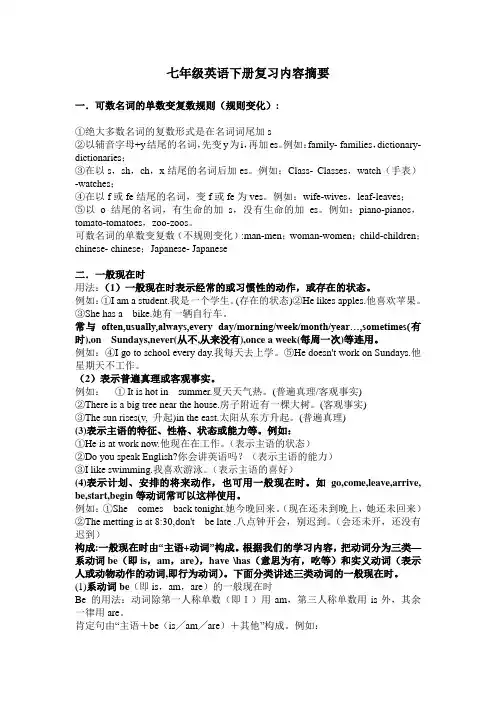
七年级英语下册复习内容摘要一.可数名词的单数变复数规则(规则变化):①绝大多数名词的复数形式是在名词词尾加s②以辅音字母+y结尾的名词,先变y为i,再加es。
例如:family- families,dictionary- dictionaries;③在以s,sh,ch,x结尾的名词后加es。
例如:Class- Classes,watch(手表)-watches;④在以f或fe结尾的名词,变f或fe为ves。
例如:wife-wives,leaf-leaves;⑤以o结尾的名词,有生命的加s,没有生命的加es。
例如:piano-pianos,tomato-tomatoes,zoo-zoos。
可数名词的单数变复数(不规则变化):man-men;woman-women;child-children;chinese- chinese;Japanese- Japanese二.一般现在时用法:(1)一般现在时表示经常的或习惯性的动作,或存在的状态。
例如:①I am a student.我是一个学生。
(存在的状态)②He likes apples.他喜欢苹果。
③She has a bike.她有一辆自行车。
常与often,usually,always,every day/morning/week/month/year…,sometimes(有时),on Sundays,never(从不,从来没有),once a week(每周一次)等连用。
例如:④I go to school every day.我每天去上学。
⑤He doesn't work on Sundays.他星期天不工作。
(2)表示普遍真理或客观事实。
例如:① It is hot in summer.夏天天气热。
(普遍真理/客观事实)②There is a big tree near the house.房子附近有一棵大树。
(客观事实)③The sun rises(v, 升起)in the east.太阳从东方升起。
可数名词单数变复数的原则名词单数变复数口诀(一) 规则变化名词单数变复数,直接加 -s 占多数;s, x, z, ch, sh 来结尾,直接加上 -es;词尾是 f 或 fe,加 -s 之前先变 ve;辅母 + y 在词尾,把 y 变 i 再加 -es;Y 前若是元音字,y 不变直接加s;词尾字母若是 o,常用三个已足够,要加 -es 请记好,hero, tomato, potato。
少数名词较特殊,单复数都一致;(二) 不规则变化男人女人 a 变 e,鹅足牙齿 oo 变 ee;老鼠虱婆也好记, ous 变 ic;孩子加上 ren,鱼鹿绵羊不用变。
man-men 男子woman-women 女人foot-feet 脚goose-geese 鹅tooth-teeth 牙齿mouse-mice 老鼠child-children 小孩louce-lice(虱子)sheep-sheep 绵羊 fish → fish鱼deer-deer 鹿Chinese-Chinese 中国人Japanese-Japanese 日本人【解说】:1.英语名词有单数和复数的区别,单数表示“一个”,复数表示“多于一个。
”名词由单数变复数,多数是规则的变,直接加–s。
s在元音或浊辅音后读[z],在清辅音后面读成[s],在[t]后与[t]在一起读成[ts],在[d]后与[d]一起读成[dz]。
cups杯子friend→friends朋友cat→cats猫style→styles风格 days日子hands手hats帽子2、以s,z,sh,ch,x结尾的词在词尾加-es,读[iz]classes班级 buses 公共汽车buzz-buzzes蜜蜂嗡嗡声boxes 盒子 watches手表quiz→q uizzes 测验3、以“元音字母+y”结尾的词,加-s,读作[z];以辅音字母+y 结尾的词,变y为i,再加-es,读[iz]。
army-armies 军队story-stories故family-families家factory-factories工厂 baby-babies宝贝以“元音字母+y”结尾时,-y 不变,直接加 -s。
名词单数变复数变化规则
在英语中,名词的单数和复数形式有着不同的变化规则。
以下是常见的单数变复数变化规则:
1. 一般情况下,在名词后面加上“-s”来表示复数形式,例如:
- Cat(单数)— Cats(复数)
- Dog(单数)— Dogs(复数)
2. 对于以“s”, “ss”, “sh”, “ch”, “x” 和“z”结尾的名词,直接在后面加上“-es”来表示复数形式,例如:
- Bus(单数)— Buses(复数)
- Class(单数)— Classes(复数)
3. 对于以“-y”结尾的名词,如果前面是辅音字母,则改“-y”为“-i”,再加上“-es”来表示复数形式,例如:
- Baby(单数)— Babies(复数)
- City(单数)— Cities(复数)
4. 对于以“-f”或“-fe”结尾的名词,将“f”或“fe”改为“v”,再加上“-es”来表示复数形式,例如:
- Leaf(单数)— Leaves(复数)
- Wife(单数)— Wives(复数)
5. 特殊情况下,有些名词的单数形式和复数形式完全相同,例如:
- Deer(单数和复数)
- Sheep(单数和复数)
总之,掌握名词单数变复数的规则对于学习英语来说非常重要。
希望以上内容能够帮助你更好地理解名词单数和复数形式的变化规则。
英语名词单数变复数规则英语名词单数变复数的规则一、绝大多数的可数名词的复数形式,是在该词末尾加上后辍-s。
读音变化:结尾是清辅音读[s],结尾是浊辅音或元音读[z]。
例:friend→friends; cat→cats; style→styles; sport→sports; piece→pieces二、凡是以s、z、x、ch、sh结尾的词,在该词末尾加上后辍-es 构成复数。
读音变化:统一加读[iz]。
例:bus→buses; quiz→quizzes; fox→foxes; match→matches; flash→flashes三、以辅音字母+y结尾的名词,将y改变为i,再加-es。
读音变化:加读[z]。
例:candy→candies; daisy→daisies; fairy→fairies; lady →ladies; story→stories四、以-o结尾的名词,如果不是外来词或缩写,就加-es,否则加-s构成复数。
读音变化:加读[z]。
例:tomato→tomatoes; potato→potatoes; torpedo→torpedoes; bingo→bingoes反例:silo→silos; piano→pianos(外来词); photo→photos; macro→macros(缩写词)五、以-f或-fe结尾的名词,多为将-f或-fe改变为-ves,但有例外。
读音变化:尾音[f]改读[vz]。
例:knife→knives; life→lives; leaf→leaves; staff→staves; scarf→scarves反例:roof→roofs六、以-us结尾的名词(多为外来词),通常将-us改变为-i构成复数。
读音变化:尾音[Es]改读[ai],其中[kEs]要改读为[sai],[gEs]要改读为[dVai]。
例:fungus→fungi; abacus→abaci; focus→foci; cactus→cacti; cestus→cesti七、以-is结尾的名词,通常将-is改变为-es。
可数名词单数变复数的规则(实用版)编制人:__________________审核人:__________________审批人:__________________编制单位:__________________编制时间:____年____月____日序言下载提示:该文档是本店铺精心编制而成的,希望大家下载后,能够帮助大家解决实际问题。
文档下载后可定制修改,请根据实际需要进行调整和使用,谢谢!并且,本店铺为大家提供各种类型的实用范文,如演讲致辞、合同协议、条据文书、策划方案、总结报告、简历模板、心得体会、工作材料、教学资料、其他范文等等,想了解不同范文格式和写法,敬请关注!Download tips: This document is carefully compiled by this editor. I hope that after you download it, it can help you solve practical problems. The document can be customized and modified after downloading, please adjust and use it according to actual needs, thank you!In addition, this store provides various types of practical sample essays, such as speeches, contracts, agreements, documents, planning plans, summary reports, resume templates, experience, work materials, teaching materials, other sample essays, etc. Please pay attention to the different formats and writing methods of the model essay!可数名词单数变复数的规则可数名词单数变复数的规则(最新)一般来看,有关可数名词单数变复数的规则:直接在名词末尾加s。
索罗学院
怎样把单数句子变为复数句子?
单数句子变复数大家要重点注意五个方面的变化,分别是:
1、人称代词主格单数变成相应的人称代词主格复数,即:I → we ; you(你)→ you (你们);she , he , it → they. 如:She is a girl. →They are girls.
2. am ,is 变为 are。
如:Iam a student.→ We are students.
3.不定冠词 a, an 要去掉,固定搭配除外。
如:He is a boy.→They are boys.
4.可数名词的单数要变为复数形式。
如:It is a cat.→ They are cats.
5.指示代词 this , that 分别变为 these, those。
如:This is a book. →These are books.
注:只要大家按照上面的要点来做题,应该就不会再有问题。
此外,还须注意的是并不是所有的单数句子都可以变成复数句子。
例如:My name is Kate. 我叫凯特。
本文由索罗学院整理索罗学院是一个免费的中小学生学习网,上面有大量免费学习视频,欢迎大家前往观看!。
【发卷日期】2013年______月_______日 【学生姓名】__________________________一、如何把“单数句”变成“复数句”:1、 “人称代词/物主代词/反身代词的单数形式”变成相应的“人称代词/物主代词/反身代词的复数形式”。
也就是说:2、 be 动词变成相应的复数形式:am/is 变为___________,was 变为___________。
3、 不定冠词a/an 要________________________(去掉/保留),固定搭配除外。
例如:He is a boy.→They are boys.4、 指示代词:this 变为__________________,that 变为__________________。
例如:This is a book.→These are books.5、 man 和woman 作定语修饰可数名词时,要在"数"上与被修饰名词保持一致。
也就是说,当man 和woman 修饰可数名词....时,在整个句子变成复数的情况下,它 们也变为复数形式:___________________________和___________________________。
例如:She is a woman teacher.→They are women teachers.【注意】当名词修饰名词表“性质”时,不作变化。
如:apple tree → apple trees6、 单数句变复数句时,句中的形容词、副词、定冠词、特殊疑问词、介词短语和感叹词等__________________________________________________(必须改变/保持不变)。
例如:Who is she? 她是谁?→ Who are they? 她们是谁?7、 有的英语单数句不可以变成复数句,必须根据题目的实际情况进行具体分析。
例如:My name is Kate. 我叫凯特。
Three plus two is five. 三加二等于五。
8、 可数名词的单数形式要变为_______________形式。
例如:It is a cat. → They are cats.book 书 →house 房子 →day 日子 → ruler 尺子 →bus 公共汽车 → waitress 女服务员 → dress 连衣裙 → glass 玻璃杯 → class 班 → box 盒子 → fox 狐狸 → dish 碟子 → brush 刷子 →watch 手表 →peach 桃子 → coach 教练 →【注意】有些单词例外,它们本身就以字母s 结尾,如:news 新闻(不可数名词)wife妻子→knife小刀→thief小偷→shelf架子→self自我→life生命→leaf树叶→wolf狼→candy糖果→country国家→family家庭→city城市→story故事→party舞会→library图书馆→factory工厂→baby婴儿→dictionary字典→【注意】有些单词例外:roof屋顶→roofs,safe保险箱→safes,chief长官→chiefsphoto照片→piano钢琴→studio工作室→radio收音机→zoo动物园→bamboos,kangaroo袋鼠→kangaroos(2)一般表示有生命含义的词,加es。
例如:hero英雄→tomato番茄→potato土豆→(3)有的既可加s,也可加es。
zero零→volcano火山→tobacco烟丝→tooth牙齿→businessman商人→foot脚→fireman消防员→goose鹅→policeman警察→man男人→postman邮递员→woman女人→child孩子→fish鱼→mouse老鼠→sheep绵羊→deer鹿→【注意】(1)与man和woman构成的合成词,两部分都要变成复数形式。
例如:男消防员(单数)man fireman →男消防员(复数)men firemen女医生(单数)woman doctor →女医生(复数)women doctors (2)但要与下列情况区分开来:男学生(单数)boy student →男学生(复数)boy students女学生(单数)girl student →女学生(复数)girl students8.集体名词:表示同一类别的人、动物或物件的集合体的名称,叫做集体名词。
(1)集体名词中有的是可数名词。
例如:family家庭,class班,team队,group小组,army军队,police警察(2)集体名词中有的是不可数名词,形式上都用单数形式。
例如:clothing衣服,furniture家具(3)如果表示整体概念时,作单数看待,谓语动词用单数。
例如:Our team needs money to play in another city.我们的球队需要资金去另一个城市打球。
(4)如果强调的是集体中的个体成员时,作复数看待,谓语动词用复数。
例如:My family are very well. 我的家人都很好。
9.合成名词:合成名词必须用连字符“-”把前后的单词连起来;无论连起来的词有多少个,只要有连字符连接,统统视为一个单词;合成词中的任何一个单词都不能变复数。
合成名词用作定语,常见的有两种形式:(1)数词-名词。
例如:一个7天的假期a ____________________________________________________ holiday 一台10小时的手术a ______________________________________________ operation (2)数词-名词-形容词。
例如:一位2米高的篮球运动员a _________________________________ basketball player 一栋85米高的大楼a ________________________________________________ building 【练习】将下列各单数句改成复数句:例:(单数句)I am a student. →(复数句)We are students.1.I am not a League member.______________________________________________________________________________________________________________ _____________________________________________________________________________________________________________ 2.You are a child.______________________________________________________________________________________________________________ _____________________________________________________________________________________________________________ 3.He is a tall man.______________________________________________________________________________________________________________ _____________________________________________________________________________________________________________ 4.She is a clever lady.______________________________________________________________________________________________________________ _____________________________________________________________________________________________________________ 5.It is a box.______________________________________________________________________________________________________________ _____________________________________________________________________________________________________________ 6.This is my knife.______________________________________________________________________________________________________________ _____________________________________________________________________________________________________________ 7.That is her piano.______________________________________________________________________________________________________________ _____________________________________________________________________________________________________________ 8.There is a pen in the pencil-case.______________________________________________________________________________________________________________ _____________________________________________________________________________________________________________ 9.There was a tree in front of the house.______________________________________________________________________________________________________________ _____________________________________________________________________________________________________________ 10.There will be a party on Saturday.______________________________________________________________________________________________________________ _____________________________________________________________________________________________________________ 11.I have a lovely dog.______________________________________________________________________________________________________________ _____________________________________________________________________________________________________________ 12.You should go there with me.______________________________________________________________________________________________________________ _____________________________________________________________________________________________________________ 13.His father can drive a bus.______________________________________________________________________________________________________________ _____________________________________________________________________________________________________________ 14.Her mother always goes to work on foot.______________________________________________________________________________________________________________ _____________________________________________________________________________________________________________ 15.The boy loves his grandparent.______________________________________________________________________________________________________________ _____________________________________________________________________________________________________________ 16.The girl likes the dress very much.______________________________________________________________________________________________________________ _____________________________________________________________________________________________________________ 17.There is a computer on the desk.______________________________________________________________________________________________________________ _____________________________________________________________________________________________________________ 18.The radio is on the shelf.______________________________________________________________________________________________________________ _____________________________________________________________________________________________________________ 19.Are you a policewoman?______________________________________________________________________________________________________________ _____________________________________________________________________________________________________________ 20.Is he an English teacher?______________________________________________________________________________________________________________ _____________________________________________________________________________________________________________ 21.Does she come from Canada?______________________________________________________________________________________________________________ _____________________________________________________________________________________________________________ 22.Is it a happy story?______________________________________________________________________________________________________________ _____________________________________________________________________________________________________________ 23.Is there a mouse under the desk?______________________________________________________________________________________________________________ _____________________________________________________________________________________________________________ 24.How old is her child?______________________________________________________________________________________________________________ _____________________________________________________________________________________________________________ 25.It isn’t an Italian car.______________________________________________________________________________________________________________ _____________________________________________________________________________________________________________ 26.Is this a black dress?______________________________________________________________________________________________________________ _____________________________________________________________________________________________________________ 27.Is there a man in the living room?______________________________________________________________________________________________________________ _____________________________________________________________________________________________________________ 28.What is that? It’s a dictionary.______________________________________________________________________________________________________________ _____________________________________________________________________________________________________________ 29.Where is his toothbrush?______________________________________________________________________________________________________________ _____________________________________________________________________________________________________________ 30.What colour is the boy’s new bicycle?______________________________________________________________________________________________________________ _____________________________________________________________________________________________________________ 31.How does he go to school?______________________________________________________________________________________________________________ _____________________________________________________________________________________________________________ 32.Which is her sister’s watch?______________________________________________________________________________________________________________ _____________________________________________________________________________________________________________。